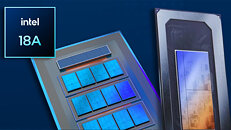- Joined
- Aug 19, 2017
- Messages
- 3,153 (1.10/day)
During Barclays 22nd Annual Global Technology Conference, Intel was a guest and two of the interim company co-CEOs Michelle Johnston Holthaus and David Zinsner gave a little update on the state of affairs at Intel. One of the most interesting aspects of the talk was Intel's upcoming "Panther Lake" processor—a direct successor to Intel Core Ultra 200S "Arrow Lake-H" mobile processors. The company confirmed that Panther Lake would utilize an Intel 18A node and that a few select customers have powered on Panther Lake on the E0 engineering sample chip. "Now we are using Intel Foundry for Panther Lake, which is our 2025 product, which will land on 18A. And this is the first time that we're customer zero in a long time on an Intel process," said interim co-CEO Michelle Johnston Holthaus, adding, "But just to give some assurances, on Panther Lake, we have our ES0 samples out with customers. We have eight customers that have powered on, which gives you just kind of an idea that the health of the silicon is good and the health of the Foundry is good."
While we don't know what ES0 means for Intel internally, we can assume that it is one of the first engineering samples on the 18A. The "ES" moniker usually refers to engineering samples, and zero after it could be the first design iteration. For reference, Intel's "Panther Lake-H" will reportedly have up to 18 cores: 6 P-cores, 8 E-cores, and 4 LP cores. The design brings back low-power island E-cores in the SoC tile. The P-cores use "Cougar Cove," which should have a higher IPC than "Lion Cove," while keeping the existing "Skymont" E-cores. The SoC tile may move from Arrow Lake's 6 nm to a newer process to fit the LP cores and an updated NPU. The iGPU is said to use the Xe3 "Celestial" architecture. With Arrow Lake-H launching in early 2025, Panther Lake-H likely won't arrive until 2026.

View at TechPowerUp Main Site | Source
While we don't know what ES0 means for Intel internally, we can assume that it is one of the first engineering samples on the 18A. The "ES" moniker usually refers to engineering samples, and zero after it could be the first design iteration. For reference, Intel's "Panther Lake-H" will reportedly have up to 18 cores: 6 P-cores, 8 E-cores, and 4 LP cores. The design brings back low-power island E-cores in the SoC tile. The P-cores use "Cougar Cove," which should have a higher IPC than "Lion Cove," while keeping the existing "Skymont" E-cores. The SoC tile may move from Arrow Lake's 6 nm to a newer process to fit the LP cores and an updated NPU. The iGPU is said to use the Xe3 "Celestial" architecture. With Arrow Lake-H launching in early 2025, Panther Lake-H likely won't arrive until 2026.

View at TechPowerUp Main Site | Source






